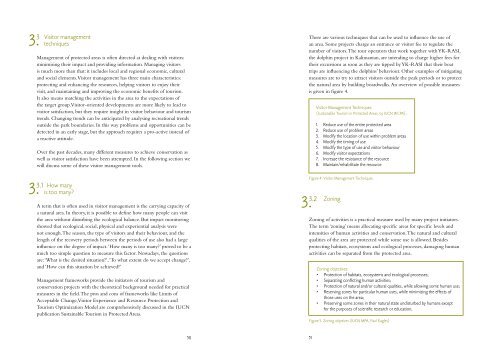OMSLAG 5.indd - IUCN
OMSLAG 5.indd - IUCN
OMSLAG 5.indd - IUCN
Create successful ePaper yourself
Turn your PDF publications into a flip-book with our unique Google optimized e-Paper software.
3. 3<br />
Visitor management<br />
techniques<br />
Management of protected areas is often directed at dealing with visitors:<br />
minimising their impact and providing information. Managing visitors<br />
is much more than that: it includes local and regional economic, cultural<br />
and social elements. Visitor management has three main characteristics:<br />
protecting and enhancing the resources, helping visitors to enjoy their<br />
visit, and maintaining and improving the economic benefits of tourism.<br />
It also means matching the activities in the area to the expectations of<br />
the target group. Visitor-oriented developments are more likely to lead to<br />
visitor satisfaction, but they require insight in visitor behaviour and tourism<br />
trends. Changing trends can be anticipated by analysing recreational trends<br />
outside the park boundaries. In this way problems and opportunities can be<br />
detected in an early stage, but the approach requires a pro-active instead of<br />
a reactive attitude.<br />
Over the past decades, many different measures to achieve conservation as<br />
well as visitor satisfaction have been attempted. In the following section we<br />
will discuss some of these visitor management tools.<br />
How many 3. is too many?<br />
3.1<br />
A term that is often used in visitor management is the carrying capacity of<br />
a natural area. In theory, it is possible to define how many people can visit<br />
the area without disturbing the ecological balance. But impact monitoring<br />
showed that ecological, social, physical and experiential analysis were<br />
not enough. The season, the type of visitors and their behaviour, and the<br />
length of the recovery periods between the periods of use also had a large<br />
influence on the degree of impact. ‘How many is too many?’ proved to be a<br />
much too simple question to measure this factor. Nowadays, the questions<br />
are: ‘What is the desired situation?’, ‘To what extent do we accept change?’,<br />
and ‘How can this situation be achieved?’<br />
Management frameworks provide the initiators of tourism and<br />
conservation projects with the theoretical background needed for practical<br />
measures in the field. The pros and cons of frameworks like Limits of<br />
Acceptable Change, Visitor Experience and Resource Protection and<br />
Tourism Optimization Model are comprehensively discussed in the <strong>IUCN</strong><br />
publication Sustainable Tourism in Protected Areas.<br />
50 51<br />
There are various techniques that can be used to influence the use of<br />
an area. Some projects charge an entrance or visitor fee to regulate the<br />
number of visitors. The tour operators that work together with YK-RASI,<br />
the dolphin project in Kalimantan, are intending to charge higher fees for<br />
their excursions as soon as they are tipped by YK-RASI that their boat<br />
trips are influencing the dolphins’ behaviour. Other examples of mitigating<br />
measures are to try to attract visitors outside the peak periods or to protect<br />
the natural area by building boardwalks. An overview of possible measures<br />
is given in figure 4.<br />
Figure 4. Visitor Management Techniques<br />
3. 3.2<br />
Visitor Management Techniques<br />
(Sustainable Tourism in Protected Areas, by <strong>IUCN</strong> WCPA):<br />
1. Reduce use of the entire protected area<br />
2. Reduce use of problem areas<br />
3. Modify the location of use within problem areas<br />
4. Modify the timing of use<br />
5. Modify the type of use and visitor behaviour<br />
6. Modify visitor expectations<br />
7. Increase the resistance of the resource<br />
8. Maintain/rehabilitate the resource<br />
Zoning<br />
Zoning of activities is a practical measure used by many project initiators.<br />
The term ‘zoning’ means allocating specific areas for specific levels and<br />
intensities of human activities and conservation. The natural and cultural<br />
qualities of the area are protected while some use is allowed. Besides<br />
protecting habitats, ecosystems and ecological processes, damaging human<br />
activities can be separated from the protected area.<br />
Zoning objectives:<br />
• Protection of habitats, ecosystems and ecological processes;<br />
• Separating conflicting human activities;<br />
• Protection of natural and/or cultural qualities, while allowing some human use;<br />
• Reserving zones for particular human uses, while minimizing the effects of<br />
those uses on the area;<br />
• Preserving some zones in their natural state undisturbed by humans except<br />
for the purposes of scientific research or education.<br />
Figure 5. Zoning objetives (<strong>IUCN</strong> MPA, Paul Eagles)
















